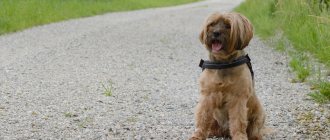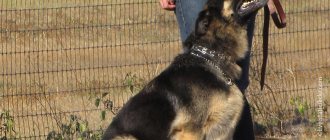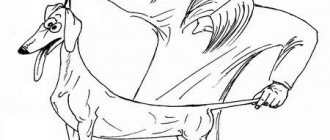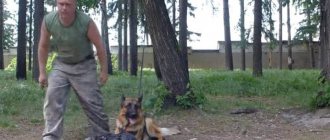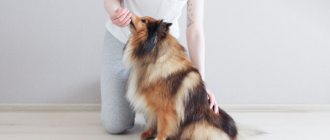An ill-mannered dog is unpleasant, troublesome and even unsafe. Especially on a walk, when there are so many unusual and distracting factors around. Therefore, it is extremely important to teach your dog the “near” command to avoid unwanted situations.
Photo: sasha
If the dog does not know or does not follow the “near” command, during a walk it will constantly pull on the leash, which is extremely inconvenient. And if you walk without a leash, then, for example, he may chase a cat or suddenly run up to a child, thereby scaring him.
Mastering the seemingly simple command “here” can be a difficult task for a dog. We will tell you how best to conduct training to achieve optimal results.
What are the dangers of a dog not knowing the “near” command?
The dog’s execution of the “here” command is not only convenient and useful for the owner, but also important for the safety of the dog itself.
In the modern world, there are many dangers for a dog on the street, which he is not able to recognize on his own:
- Spoiled food or other waste may be attractive to your dog and cause poisoning if eaten.
- Fast-moving vehicles that your dog may not notice are approaching can result in serious injury and even death.
- Other animals that have aroused the dog’s interest may turn out to be aggressive, as well as suffer from dangerous diseases.
Which delicacy to choose
The choice of treat is a matter solely of the animal’s taste preferences. As a rule, dogs like meat and offal the most. Meat can be given both raw and boiled.
Of course, many pets prefer other products (cheese, cottage cheese, vegetables, canned dog food, etc.) to meat products. It is important to choose the treat that your dog likes the most. To do this, you need to experiment and, through trial and error, find the treat that is right for your pet.
What should a dog do on the command “near”
A trained dog on the command “near” should move to your left so that its right front leg is level with your left leg.
When the pace of walking changes, the dog should adapt to it, when turning, it should turn with you, and still remain with its right shoulder blade at your left leg - without running ahead or falling behind.
Photo: Malcolm Parnell
When you stop, the dog should sit at your left leg and wait for the next command or resumption of movement.
Expert advice
Important Recommendations:
- When improving a skill, you should first give a command and then make changes.
- You can't let your dog manipulate you.
- You need to monitor the mood and well-being of your four-legged friend.
- You should also teach the command by gesture, using a treat as a reward.
- Also, it is worth remembering about the dog’s concentration: for a puppy, it is optimal to break the training into 5-6 blocks of 2-3 minutes each. An adult dog needs to be trained taking into account its character traits.
Does training success depend on the dog's breed?
As a rule, all dogs are trainable, regardless of breed and size; differences can only be in the speed of mastering the command. Some breeds (retrievers, poodles, German shepherds, papillons, shelties, Dobermans and Rottweilers) learn faster, some (chow-chows, bulldogs, Afghan hounds) take longer, but it all depends on the owner, his readiness and efforts in training the pet.
Also, the speed of learning can be affected by the characteristics of the pet - dogs with high activity are less able to keep their attention on the task at hand.
Choosing a place to study
When choosing a place where your pet will be further trained, it is important to take into account that a foreign place will scare away the dog. It is easier for a pet to perceive information in an environment where it is familiar with the surrounding objects. Familiar parks where the owner and his pet used to walk are suitable for training. This will protect him from possible stress.
If the owner wants to train the pet in a specific place, it is better to go there in advance, preferably several times. This will give your pet confidence in the place, which will make it easier to conduct the lesson outside.
Training conditions
You should start training a dog only if it is in normal physical condition (not sick, not depressed and does not refuse food). It is better to feed the dog a couple of hours before, and take it for a walk just before practicing the commands, so that it does all the necessary things and slightly wastes energy, which will prevent absent-minded attention.
You should choose a secluded area for training - at the beginning of training, you do not want unnecessary noise and the presence of strangers, which the dog can be distracted by. It is better if it is a fairly spacious area in the fresh air that is familiar to the dog, with an even surface.
At first, it is better to avoid noisy places. Photo: Kate Hart
When the dog begins to make progress in mastering the command, you should slightly add distractions - change the training location or invite spectators. However, if the dog is very distracted, it is too early to leave the secluded training area.
What you need for training
To teach the “near” command, you will need a collar, a leash, treats for reward, and your favorite toy will also come in handy.
Training should be done daily for 15 minutes. If the dog is tired or distracted, it is best to stop training and continue the next day.
Which delicacy to choose
Treats for reward during training should be in the form of small pieces, not crumble and not get your hands dirty. You can only choose the most suitable treat for your dog through experience. These can be pieces of chicken, sausages, vegetables, fruits, cheese, dry food, and store-bought treats.
Industrially made treats for dogs
Some dogs willingly work for pieces of biscuits. The treat needs to be chosen so that it is desirable for your dog. It is better to choose several types of treats and alternate them periodically so that the dog does not get bored with them.
When to use a special collar
It is not always possible to teach a dog commands using ordinary techniques and equipment. If the dog is a fairly large breed, disobedient, hyperactive or aggressive, then a special collar can help you: a choke collar, a strict collar or an electronic collar.
All this ammunition requires knowledge of its practical use and special care in use.
Usage
The choke collar is used for training dogs from 5 months. It is unacceptable to use on puppies and is not recommended for use on small breed dogs, as there is a high risk of injury to the cervical spine and suffocation.
The accessory is placed around the neck and a leash is attached to the end through which the noose does not slip. The collar should not put pressure on the neck, so it should be worn so that two fingers folded together can be inserted between it and the neck. A collar that is too tight will cause breathing problems. If everything is done correctly, then when tensioned, the loop will tighten, and after reducing the tension, the loop will loosen.
Choke collars are not intended for everyday use; they are worn only during training and training. Many dog owners purposefully buy nooses for daily walks, considering them convenient, because they hang freely and do not spoil the hair, and do not cause inconvenience to the dog if it does not pull the leash. Such use is unacceptable, because there are other types of collars for such purposes.
During the training process, you should not pull the noose. You need to show the dog that it is not he who gives the direction. The trainer, holding the leash closer to the base, walks at a normal pace, abruptly changing direction, thereby tightening the leash, the dog experiences unpleasant sensations, the trainer loosens the leash and rewards the animal with a treat, stroking or words. You should not leave an animal in a choke collar unattended. As you watch the video, notice that the trainer does not jerk the leash sharply.
How to teach a dog to walk next to you on a leash
The process of teaching a dog the “near” command depends on its characteristics – age, size, temperament, obedience and much more.
Classic teaching method
- Call the dog to you with the command “come” and sit it by your left leg using the command “sit”. Hold the leash in your left hand, its length should be approximately 30-40 cm.
- Start the movement and give the command “near”, after a moment tugging the leash with a short, confident jerk and encouraging the dog to follow you (the jerk must follow strictly after the command “near”).
- Continue moving in a straight line. The leash should hang freely. If your pet deviates from the required trajectory, adjust its position with the command “near” and jerking the leash. Your task is to get the dog's right front paw to move next to your left leg, preventing the pet from running ahead or falling behind.
- If the dog walks nearby, do not skimp on praise, thereby encouraging it. Keep moving.
Photo: FlickerFred
- After successfully walking a few steps, stop, sit him by your left leg with the command “sit” and give him a treat. Every time your pet successfully completes a command, actively praise it, give it a treat, or pet it. Let him feel how glad you are that he did everything right. After practicing the command “nearby” several times in a row, let him run with the command “walk” or “maybe” if you give him a toy.
- After the dog has confidently mastered walking alongside in a straight line, you can move on to changing the pace of walking, turning and stopping. Before each stop, change of direction or pace, the command “near” should be used as a sign to the dog of changes in traffic conditions.
Using bait
This compromise method can be used for puppies and affectionate dogs of non-guard breeds, but it does not guarantee that the dog will strictly follow the command in the future.
Video about using bait
The principle of the method is simple - you lure the dog after you with bait - a treat or a favorite toy. The dog should be at your left leg, the leash should not be taut. Simply hold the desired treat in your hand and hold it at nose level so your dog can smell the scent, and move on.
If it follows the bait, praise it. Then stop and give the command “sit.”
If the pet complies with the command, praise it and give it a treat, pet it.
Helper Methods
Additional tricks may come in handy to solve difficulties you may encounter when practicing a command.
Movement along the wall.
Indispensable if the dog has difficulty moving next to you and is actively trying to move away from you to the side. In this case, you need to find a flat wall (fence) along which to conduct training.
In this case, the dog is between you and a flat vertical surface and its movements to the sides are limited - all that remains is to use a leash to regulate the correct position so that the dog does not run ahead or lag behind.
Training using special collars.
When exposed to a special collar, the dog causes a feeling of discomfort or pain, from which it tries to get rid of it and takes the position you require.
- Strict collar usually consists of individual links or plates equipped with spikes curved inward. When the leash is pulled, the strict collar tightens, pressing its spikes onto the skin of the animal’s neck.
String collar
To avoid unnecessary injury to the dog's skin, the snare collar must be worn correctly: higher than a regular collar, almost immediately behind the animal's ears. - A choke collar is a loop made of various materials that tightens when the leash is pulled, causing discomfort and subsequent weakening of the dog's pressure on the collar.
- The electronic collar responds to your command given using a special remote control, influencing the dog in one of the following ways: sound, vibration or a weak electric current. Learn more about electronic collars from the article
All special collars require special care in use and before using them, it is better to consult with a training specialist who will help you choose equipment specifically for your pet, taking into account its characteristics and the required level of impact.
Types of choke collars
The range of this type of accessories is quite wide, and although the principle of operation is the same, the classification is carried out according to the types of materials from which choke collars of different lengths are made.
The most common option is nylon rope collars. They are woven in different ways from a single-color thread or several colored threads, with a pattern. They are durable and easy to adjust, because the metal ring slides easily over the nylon. The ends of some models can be trimmed with artificial or natural leather. The best option for dogs with long hair, as nylon collars do not tangle or spoil the appearance of the coat.
Metal choke collars in the form of one-, two-, or three-row steel chains of different weaving densities have also become widespread. Chains with smooth links tightly fastened together, in contrast to looser weaving, are more comfortable for the animal.
Some manufacturers produce rope choke collars made of 100% cotton, natural and artificial leather. It is better to buy round, rather than flat, choke collars made of leather, since round ones glide better and damage the wool less.
Fastening elements - rings, are made of brass, chrome and other metals. Some models provide an adjusting ring that allows you to tighten the loop to the set point, to the so-called “stop,” thereby reducing the risk of injury to the animal’s neck, but at the same time the dog will experience discomfort.
Choke collars TRIOL (Russia, 440 rubles), Hanter (Germany, 560 rubles), Trixie (Germany, 200-250 rubles), BelProfiDog (Republic of Belarus, 960 rubles), Karlie (China, 300 rubles), have become widespread on the market. Ferplast (560 rubles).
How to teach a dog to walk next to you without a leash
You should start learning to walk side by side without a leash only when the dog has learned to confidently walk side by side on a leash, without straining it and maintaining the required position.
To practice walking side by side without a leash, make the leash longer and give a command when the pet walks on a loose leash.
Gradually increase the distance; when the distance exceeds 5 meters, call the dog with the command “come to me”, and only then give the command “near”. And don’t forget to reward with praise, affection or treats.
Photo: Scoutdogs (Chris)
When your pet masters the “near” command from a distance of 5 meters, you can begin practicing the command at a distance when the dog walks without a leash.
However, remember that mastering walking side by side without a leash does not mean that you can eliminate walking on a leash - the dog may gradually become spoiled and stop maintaining the distance and the necessary position in space.
Briefly about the main thing
- Choose a quiet and familiar place for the dog to train. Eliminate all distractions.
- Take the treat that is most valuable to your pet. Do not try to offer the animal a treat that is not interesting to him.
- If you are not sure that the dog will not run away during training, put your pet on a leash, but do not use it for training by jerking.
- Using a treat, move the animal to the “near” position near your left knee, then praise the pet. Gradually increase the criteria and make the task more difficult: move forward, turn, stop, speed up or slow down. Also, you can learn the “target” command and use it to learn the “near” command. Subsequently, the target is removed and the dog independently carries out the command.
We hope that this article will help you in training your pet. If you have any questions, ask them in the comments. We wish you good luck in training your four-legged dogs!
Possible errors and problems
When training, mistakes are possible, the admission of which complicates training or makes it incorrect.
- Jerk before the command is given. He knocks the dog down and doesn’t make it clear what they want from him.
- Driving a dog on a tight leash. Execution of the “nearby” command must be carried out on a loose leash, and subsequently without it, otherwise the dog will get used to the constant feeling of tension on the collar and will begin to consider this the norm.
Photo: Scott 97006
- Giving a command with different intonation. The dog will not be able to remember all your intonations and associate them with a specific command, and a rude tone may even frighten him.
- Repeating the command when the dog walks nearby. If the dog follows a command, it should not be repeated again. This way, the pet can associate repeated issuance of a command with the norm and will carry it out only on a double command.
- The position of the dog when walking side by side is half a length forward/backward. This position of the dog makes it difficult for him to give other commands with a gesture, and also slows down the pet’s reaction to changing traffic conditions.
- Parallel study of different commands. It is difficult for an animal to learn several commands at once; it is worth practicing them one by one.
- Punishment for failure to follow commands. When teaching a dog commands, it is strictly not recommended to raise your voice or physically punish it. In this case, your pet’s training will be associated with negative emotions and will become ineffective.
Photo: Virginia State Parks
Raising a dog is a labor-intensive process that requires patience and time, but the result can not only ensure its safety and save you stress, but also make your pet a well-deserved source of pride.
Basic recommendations
When studying on your own, it is very important to follow a number of rules and avoid common mistakes. You can find the main recommendations below.
Important Rules
During training, adhere to the following rules:
- Monitor your pet's well-being. If there is the slightest sign of discomfort, the training session should be postponed to another day.
- Divide the lesson into several stages so as not to get bored with the monotony. Be sure to entertain your dog with active games if he begins to lose concentration.
- Focus on the process with your pet. Make sure you are free and will not be distracted by your phone.
- Involve all family members. The animal must follow not only your orders, but also those given by the child.
- Change direction and pace gradually and as little as possible. Otherwise, the dog will very quickly become confused and begin to boycott training.
The most important thing is patience. Don't chase quick results and try to just enjoy the process.
Skill complication
It is quite logical that it is possible to complicate the skill of moving nearby only after the dog has learned to obey the command flawlessly.
Improvement is as follows:
- changing the direction of movement;
- turns in different directions;
- change of pace (from walking to running and vice versa).
Important! Before making any changes, you must speak a command and sound a warning signal. :
- when moving to the right, the animal is directed to the right;
- when moving to the left, the pet is pulled back;
- When moving in a circle, they turn over their right shoulder.
When the animal has learned to synchronize its movement with the movement of a person, it is taught to turn in place. The operating scheme is the same as described in the previous paragraph.
Subsequently, the animal is taught to work according to a gesture and without a leash.
In the first case, clamp the leash with your right palm. They begin to move as usual, but before giving the command they slap their left palm on the leg. Initially, the gesture is duplicated by voice and physical coercion. After some time (about five or six lessons) they do only the gesture.
Important! Correct execution of a command is rewarded with praise and treats.
To consolidate the execution of a skill by command and gesture, they alternate; simultaneous use is possible only to enhance the effect.
It is also necessary to gradually train your dog to walk alongside without a leash. At first the strap should just drag behind the animal. If the pet does not obey, then they menacingly say “Nearby” and confront the student by stepping on the rope or taking it in his hand and making a sharp jerk.
After some time, the leash is removed, and all the animal’s actions are controlled only by command or gesture. As necessary, work is carried out in more difficult conditions: noise, distracting objects, unusual surroundings, etc. They also increase travel time and distance covered.
Don’t forget to periodically reinforce good work with praise and treats.
Mr. Tail recommends: training methods
When arranging your home or apartment for the arrival of a puppy, you should take care of purchasing important but necessary things. These include: a bowl, a bed, toys, etc. Also, do not forget about the collar and leash or tape measure. And if the puppy meets the first with joy, then he will treat the second with distrust and sometimes with aggression. To prevent such trouble from happening, it is important not only to choose them correctly, but also for the owner to show strength of character and have knowledge on this issue.
First introduction
Puppies begin to be accustomed to wearing a collar from the first days of life. First, the breeder hangs multi-colored threads around the neck to distinguish them. Then they are replaced with light collars. At a later age, they are gradually accustomed to a leash. It is important to choose it correctly, following certain recommendations. These include the following points:
- First, you should opt for the easy option. The maximum length of the leash should be 1.5 meters. There is no need to immediately buy a heavy leather one or a tape measure, this will be uncomfortable for the puppy and will complicate the process of getting used to it.
- It is important that the size of the accessory matches the age of the pet. For little ones, puppy options made from light fabrics are selected. The volume of the harness or collar is also important so that it does not dangle, but at the same time does not put pressure or restrict movement.
- An accessory just brought from the store should not be immediately put on your pet, because it has a foreign smell, which can frighten and cause a negative reaction on the part of the puppy. You need to wait a few days for the foreign aromas to dissipate.
- First, it is advisable to let your pet smell the ammunition, thereby showing that there is nothing scary in these items. It is worth introducing new things gradually, without insisting if the baby resists.
It is important to teach your puppy to use a leash based on positive emotions. This is difficult, but possible if you carry out the process in a playful way. The fact is that, due to their age, children are very inquisitive and perceive restrictions on their freedom negatively. This can be dealt with with a lot of patience.
If you follow some recommendations, the process of accustoming to the accessory will proceed more calmly. Among the most significant are the following:
- You need to train from 1.5-2 months of age. This is the most optimal period, since earlier the pet will not understand what they want from him, and later the process will be complicated by the developing disposition.
- As soon as the puppy gets used to the collar and stops showing excessive interest in it, you should fasten the leash.
- The first fitting of the leash should be short-term, only 2-3 minutes. At this time, it is worth switching the baby’s attention to the game, distracting him from the new thing. But you should not be allowed to chew or play with the accessory.
- Gradually increase the time spent on a leash by several minutes daily.
Home schooling
A properly selected collar with a leash should not create inconvenience for the puppy, but also should not slip off. When you first fasten the tape, you need to make sure that it does not restrict movement, dangling freely. When the training time reaches about 20 minutes, you can go for a walk within the apartment, while following the baby, without strongly limiting the directions. In the following days, it is also worth increasing the time of walking indoors, giving the pet a little direction and limiting it.
The main rule in leash training is gradualism; you should not expect quick results. Rushing can cause a negative reaction and refusal to learn to walk on a leash. Therefore, the owner should be patient.
There are several techniques to teach your pet obedience.
Loyal way
Thanks to this method, the baby’s trust in the owner will be preserved, but it will require time and patience from the puppy’s owner. It is important to follow a certain sequence of actions:
- Call the puppy to you by name, then attach the leash to the harness or collar. It is important to pet your pet and start moving. The baby is most likely to run in the opposite direction.
- When the leash tape is pulled, the owner stops. It is important to reinforce in the dog’s understanding that the owner’s actions depend on his behavior.
- You need to let the dog know that walking slowly along with a person is more effective than running, which is difficult to stop.
- With each pull followed by a stop, you should wait until the pet looks at the owner. For this they give him a treat.
- Now change direction and repeat all the above steps. Gradually, as the puppy learns, treats are replaced with stroking and verbal praise.
The hard way
It is based on strengthening reflexes and is suitable for older puppies (4 months and older). As soon as the pet jerks to the side, it is sharply pulled back. The leash is pulled with a jerk, but it is important not to cause pain to the baby, only discomfort. After a while, he will understand that it is unpleasant to run until the belt is tensioned and will begin to walk with it slack.
For puppies 5 months and older, you can purchase Parfos. This is a special collar with round teeth, which, when jerked, cause unpleasant sensations, but do not cut into the delicate skin of the pet. With such a collar the learning process will go faster.
Habit Formation
Regardless of which method is chosen for training, you should not get too carried away with monotonous walking. Due to his age and desire for outdoor games, the baby will have a protest and even a rebellion against such training, he will begin to resist. At first, it is enough to take a few dozen steps to understand whether the dog has understood the principle of walking on a leash or not. In addition, it is very important to build a trusting relationship with the puppy and establish mutual understanding. If this is not the case, the learning process will turn into agony and will drag on indefinitely.
If everything is done correctly, the animal has learned what is required of it, then after about 1-1.5 months it will develop a strong habit and the owner will be able to rejoice at a well-mannered and obedient puppy.
Walk
All dogs, even miniature breeds, need a full walk. Its time should be at least 1.5 hours. At the same time, time outside should be spent actively, with games, running, etc., and not slowly tramping around the house on a pedestrian path. Therefore, it is important to choose a route in advance.
When walking your pet, it is important to follow some rules so as not to incur the righteous wrath of neighbors and passers-by:
- It is strictly prohibited to walk dogs of any size on playgrounds. Even a small dog, such as a Pomeranian, Chihuahua or Yorkshire Terrier, can be very frightening to small children. Therefore, you should avoid them.
- When walking in the local area, be sure to clean up your pet’s excrement.
- In places where people gather, large breed dogs (Asian Shepherd, Husky, Labrador, Rottweiler, etc.) are walked only on a leash and muzzle. It is important to be polite towards others, because even an intelligent and obedient dog can suddenly rush towards a passerby and scare or bite him. The fact that the owner loves his pet, and he loves you, does not apply to strangers at all. We need to remember this!
Stage 3. Changing the direction of movement
Teaching a dog to change direction is not at all difficult. To begin, make smooth turns - turn in a semicircle. Over time, gradually begin to turn more and more sharply, eventually achieving a right angle turn. This will require about two weeks of training. Remember that, no matter how smooth the turn you make, before starting the maneuver you must give the command “Near!”

